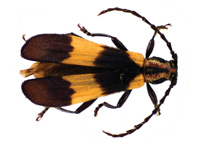Abstract
The longhorned beetle genus Elytroleptus Dugés (Cerambycidae: Cerambycinae: Trachyderini) is revised to include fifteen species. One new species is described: E. quadricostatus sp. nov. Grzymala & Miller. Three new synonymies are proposed: E. dichromaticus Linsley, 1961 syn. n. = E. divisus (LeConte, 1884); E. luteicollis Skiles & Chemsak, 1982 syn. n. = E. ignitus (LeConte, 1884); E. peninsularis Hovore, 1988 syn. n. = E. immaculipennis Knull, 1935. A lectotype is designated for E. scabricollis Bates, 1892. The genus is generally distributed throughout the southwestern United States, Mexico, and Central America (Guatemala, Honduras, Nicaragua, and Costa Rica) with one species, E. floridanus (LeConte), extending the range to the northeastern and southeastern United States. Elytroleptus is of interest to both naturalists and taxonomists as several species are lycid (Coleoptera: Lycidae) mimics with three recorded as predaceous on their own models (E. apicalis (LeConte), E. ignitus (LeConte), E. limpianus Skiles & Chemsak). Descriptions of all species are provided with an emphasis on clarifying intraspecific polychromatic variation. A key to the adult species, distribution maps, habitus images, and illustrations of mouthparts and genitalia are presented. A phylogenetic analysis of Elytroleptus is performed using twenty-one adult morphological characters. Six most parsimonious trees (L = 59; CI = 50; RI = 75) are recovered. Results suggest that Elytroleptus is monophyletic and is supported by four unambiguous synapomorphies.

